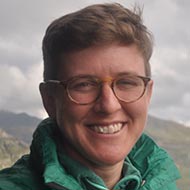Laura Stevens
Supernumerary Fellow in Earth Sciences; Associate Professor of Climate and Earth Surface Processes (ULNTF)

Contact information
Teaching
Research
My research program aims to determine how ice sheets flow and fall apart. Understanding ice sheet dynamics on Earth is critical for the prediction of past and future global ice volumes, which have direct implications for global sea level. At present, the question that drives my research is: How does ice-sheet melting drive ice-sheet flow? To approach this question, I pair geophysical observations with time-dependent inverse methods and computational modeling. I investigate Greenland and Antarctic ice sheet, ice shelf, and outlet glacier flow dynamics to better understand the physical mechanisms that destabilize ice sheets with increased surface meltwater production in our warming climate.
Current research projects include:
1. Greenland Ice Sheet dynamic response to the inland expansion of a hydrologically active ice-sheet bed.
This project combines on-ice geodetic and radar observations with geophysical inverse and forward modeling techniques to investigate stess-coupling relationships between neighboring supraglacial lakes and moulins on the western margin of the Greenland Ice Sheet. Field observations of ice-sheet surface and englacial deformation will be collected over a 16-month period from May 2021 through August 2022. Collaborators include Drs. Meredith Nettles and Jonathan Kingslake (Columbia University).
2. Antarctic ice-shelf instability caused by active surface meltwater production, movement, ponding, and hydro-fracture.
Funded by NSFGEO–NERC, this project combines field observations, numerical modeling, and remote sensing techniques to better understand ice-shelf flexure and fracture due to surface meltwater loading. Field observations of ice-shelf surface height, local weather conditions, and water body depths are currently being collected on the George VIth Ice Shelf, Antarctic Peninsula through February 2023. This project is jointly supported by the US NSF and UK NERC, with field support provided by the British Antarctic Survey in coordination with the United States Antarctic Program. Collaborators include Drs. Alison Banwell (University of Colorado Boulder), Douglas MacAyeal (University of Chicago), and Ian Willis (University of Cambridge).
Selected Publications
Stevens, L.A., Hewitt, I., Das, S.B., Behn, M.D. (2018). Relationship between Greenland Ice Sheet surface speed and modeled effective pressure. Journal of Geophysical Research: Earth Surface, 123. doi:10.1029/2017JF004581.
Stevens, L.A., Behn, M.D., Das, S.B., Joughin, I., Noel, B. P. Y., van den Broeke, M., and T. Herring (2016). Greenland Ice Sheet flow response to runoff variability. Geophysical Research Letters, 43:11,295–11,303. doi:10.1002/2016GL070414.
Stevens, L.A., Straneo, F., Das, S.B., Plueddemann, A.J., Kukulya, A.L., and M. Morlighem (2016). Linking glacially modified waters to catchment-scale subglacial discharge using autonomous underwater vehicle observations. The Cryosphere, 10:417–432. doi:10.5194/tc-10-417-2016.
Stevens, L.A., Behn, M.D., McGuire, J.J., Das, S.B., Joughin, I., Herring, T., Shean, D.E., and M.A. King (2015). Greenland supraglacial lake drainages triggered by hydrologically induced basal slip. Nature, 522:73–76. doi:10.1038/nature14480.